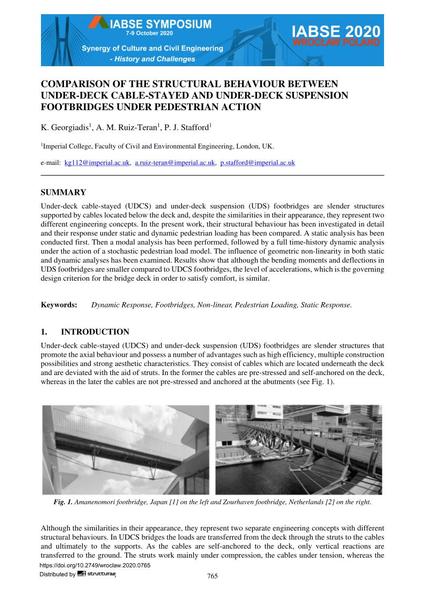Comparison of the Structural Behaviour between Under-Deck Cable-Stayed and Under-Deck Suspension Footbridges under Pedestrian Action

|
|
|||||||||||
Bibliografische Angaben
| Autor(en): |
L. Georgiadis
A. M. Ruiz-Teran P. J. Stafford |
||||
|---|---|---|---|---|---|
| Medium: | Tagungsbeitrag | ||||
| Sprache(n): | Englisch | ||||
| Tagung: | IABSE Symposium: Synergy of Culture and Civil Engineering – History and Challenges, Wrocław, Poland, 7-9 October 2020 | ||||
| Veröffentlicht in: | IABSE Symposium Wroclaw 2020 | ||||
|
|||||
| Seite(n): | 765-772 | ||||
| Anzahl der Seiten (im PDF): | 8 | ||||
| Jahr: | 2020 | ||||
| DOI: | 10.2749/wroclaw.2020.0765 | ||||
| Abstrakt: |
Under-deck cable-stayed (UDCS) and under-deck suspension (UDS) footbridges are slender structures supported by cables located below the deck and, despite the similarities in their appearance, they represent two different engineering concepts. In the present work, their structural behaviour has been investigated in detail and their response under static and dynamic pedestrian loading has been compared. A static analysis has been conducted first. Then a modal analysis has been performed, followed by a full time-history dynamic analysis under the action of a stochastic pedestrian load model. The influence of geometric non-linearity in both static and dynamic analyses has been examined. Results show that although the bending moments and deflections in UDS footbridges are smaller compared to UDCS footbridges, the level of accelerations, which is the governing design criterion for the bridge deck in order to satisfy comfort, is similar. |
||||
| Stichwörter: |
Fußgängerstege Fußgängerbrücken nichtlinear
|
||||



